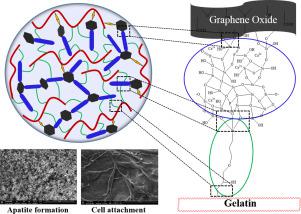Reactive & Functional Polymers ( IF 4.5 ) Pub Date : 2020-06-06 , DOI: 10.1016/j.reactfunctpolym.2020.104668 Ehsan Zeimaran , Sara Pourshahrestani , Hui Yin Nam , Nasrul Anuar bin Abd Razak , Katayoon Kalantari , Tunku Kamarul , Babak Salamatinia , Nahrizul Adib Kadri

|
Class II organic-inorganic hybrid materials have emerged as a promising replacement for the conventional bioactive glass particle-polymer composite biomaterials. Although these materials benefit from several advantages, such as controlled congruent degradation and improved cell response compared with the conventional composites, they become brittle when the inorganic-to-organic ratio exceeds an optimum value, rendering them unsuitable for tissue engineering applications. Here, a series of hybrid composite scaffolds were prepared from gelatin, tertiary bioactive glass and graphene oxide (GO) using a sol-gel/gas foaming technique. This study shows that rather than increasing the inorganic concentration to increase the mechanical stiffness, a small amount of GO (1 and 2 wt%) can be used to remarkably improve the Young's modulus of hybrid materials, by about 200%, without deteriorating the strain to failure. The hybrid scaffolds underwent a linear biodegradation, and a remarkable bioactivity reflected in a thick layer of hydroxyapatite formed on their surfaces after 14 days of immersion in carbonate buffered Dulbecco's modified Eagle's medium. The excellent biocompatibility of these scaffolds towards human adipose-derived mesenchymal stromal cells was confirmed in vitro. GO-doped organic-inorganic hybrid composite scaffolds may be ideal materials for a range of tissue engineering applications such as interface and non-load bearing bone tissue engineering.
中文翻译:

使用石墨烯纳米片的高度多孔仿生明胶/三级生物活性玻璃混合支架的工程刚度
II类有机-无机杂化材料已经成为有希望的替代常规生物活性玻璃颗粒-聚合物复合生物材料的材料。尽管这些材料具有多种优势,例如与常规复合材料相比,可控的全降解性能和改善的细胞反应性能,但当无机与有机物的比例超过最佳值时,它们会变脆,因此不适用于组织工程应用。在这里,使用明胶,三级生物活性玻璃和氧化石墨烯(GO)使用溶胶-凝胶/气体发泡技术制备了一系列杂化复合支架。这项研究表明,与其增加无机浓度以提高机械刚度,不如使用少量的GO(1和2 wt%)来显着改善Young' 混合材料的s模量约为200%,而不会使应变恶化。混合支架经历了线性生物降解,浸入碳酸盐缓冲的Dulbecco改良Eagle介质中14天后,其表面上形成的厚厚羟基磷灰石层反映出显着的生物活性。这些支架对人脂肪来源的间充质基质细胞具有极好的生物相容性体外。GO掺杂的有机-无机杂化复合材料支架可能是多种组织工程应用(例如界面和非承重骨组织工程)理想的材料。









































 京公网安备 11010802027423号
京公网安备 11010802027423号